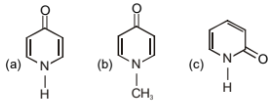Which of the following compound exhibit optical isomerism?
1. 
2. 
3. 
4. All of these



Subtopic: Stereo Isomers |
72%
To view explanation, please take trial in the course.
NEET 2025 - Target Batch
Hints
Arrange the following in order of their reactivity toward electrophilic substitution reaction:
| I. |  |
II. |  |
| III. |  |
Iv. |  |
| 1. | I > II > III > IV | 2. | IV > III > II > I |
| 3. | II > I > IV > III | 4. | II > I > III > IV |
Subtopic: Nucleophile & Electrophile |
62%
From NCERT
To view explanation, please take trial in the course.
NEET 2025 - Target Batch
Hints
To view explanation, please take trial in the course.
NEET 2025 - Target Batch
Which of the following compound requires minimum energy for free rotation across double bond between ring :
| 1. |  |
2. |  |
| 3. |  |
4. |  |
Subtopic: Aromaticity & Polarity |
To view explanation, please take trial in the course.
NEET 2025 - Target Batch
Hints
To view explanation, please take trial in the course.
NEET 2025 - Target Batch
The molecule that exhibits non-planarity is:
| 1. |  |
2. |  |
| 3. |  |
4. |  |
Subtopic: Aromaticity & Polarity |
68%
From NCERT
To view explanation, please take trial in the course.
NEET 2025 - Target Batch
Hints
To view explanation, please take trial in the course.
NEET 2025 - Target Batch
The aromatic compound among the following is:-
| 1. |  |
2. |  |
| 3. |  |
4. |  |
Subtopic: Aromaticity & Polarity |
77%
From NCERT
To view explanation, please take trial in the course.
NEET 2025 - Target Batch
Hints
Links
To view explanation, please take trial in the course.
NEET 2025 - Target Batch
Which carbocation is the most stable among the options provided?
| 1. |  |
2. |  |
| 3. |  |
4. |  |
Subtopic: Reaction Intermediates ; Preparation & Properties |
79%
From NCERT
To view explanation, please take trial in the course.
NEET 2025 - Target Batch
Hints
Links
To view explanation, please take trial in the course.
NEET 2025 - Target Batch
The presence of a halogen on the benzene ring in a nitration reaction leads to:
| 1. | Direct nitro group to come at meta and deactivate the ring due to –I effect of halogen. |
| 2. | Direct nitro group to come at ortho and para position and deactivate the ring due to –I effect of halogen. |
| 3. | Direct nitro group to come at meta and activate the ring toward nitration reaction. |
| 4. | Nitration reaction does not take place due to deactivation caused by –I effect of halogen. |
Subtopic: Types of Reaction |
72%
From NCERT
To view explanation, please take trial in the course.
NEET 2025 - Target Batch
Hints
To view explanation, please take trial in the course.
NEET 2025 - Target Batch
The pair of structures that does not represent isomers is:
| 1. |  |
2. |  |
| 3. |  |
4. |  |
Subtopic: Structural Isomers |
67%
From NCERT
To view explanation, please take trial in the course.
NEET 2025 - Target Batch
Hints
Links
To view explanation, please take trial in the course.
NEET 2025 - Target Batch
Which among these can exhibit tautomerism?

1. a only
2. b only
3. c only
4. a and c
Subtopic: Structural Isomers |
56%
To view explanation, please take trial in the course.
NEET 2025 - Target Batch
Hints
To view explanation, please take trial in the course.
NEET 2025 - Target Batch
Hints







